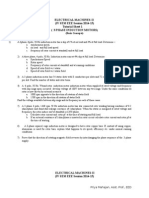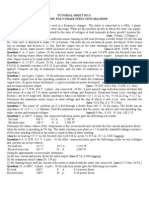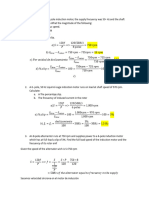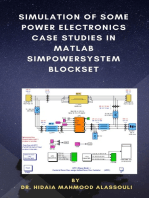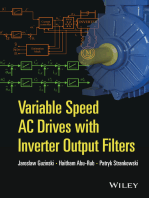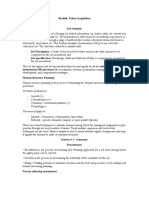0 ratings0% found this document useful (0 votes)
53 viewsAssignment 1: Electrical Machines-Ii (Elpc402)
This document contains 6 questions regarding electrical machines and induction motors. Question 1 asks about calculating number of poles, slip, speeds of stator and rotor fields for a 3-phase induction motor. Question 2 involves calculating shaft power output, rotor copper loss, and efficiency for a motor given its torque and rotor frequency. Question 3 requires calculating slip, rotor speed, power developed, rotor copper loss per phase, and rotor resistance for a motor given its power input and rotor emf frequency. Question 4 involves calculating starting current and torque using different starting methods for a small induction motor. Question 5 calculates torque at a given slip and resistance to obtain a percentage of maximum torque at starting for a motor. Question 6 finds slip at maximum torque, full
Uploaded by
Abishek BhardwajCopyright
© © All Rights Reserved
Available Formats
Download as PDF, TXT or read online on Scribd
0 ratings0% found this document useful (0 votes)
53 viewsAssignment 1: Electrical Machines-Ii (Elpc402)
This document contains 6 questions regarding electrical machines and induction motors. Question 1 asks about calculating number of poles, slip, speeds of stator and rotor fields for a 3-phase induction motor. Question 2 involves calculating shaft power output, rotor copper loss, and efficiency for a motor given its torque and rotor frequency. Question 3 requires calculating slip, rotor speed, power developed, rotor copper loss per phase, and rotor resistance for a motor given its power input and rotor emf frequency. Question 4 involves calculating starting current and torque using different starting methods for a small induction motor. Question 5 calculates torque at a given slip and resistance to obtain a percentage of maximum torque at starting for a motor. Question 6 finds slip at maximum torque, full
Uploaded by
Abishek BhardwajCopyright
© © All Rights Reserved
Available Formats
Download as PDF, TXT or read online on Scribd
You are on page 1/ 1
ASSIGNMENT 1
ELECTRICAL MACHINES-II (ELPC402)
Q1. A 3-phase, 50 Hz induction motor has a full-load speed of 1440 rpm. For this motor,
calculate the following:
(a) Number of poles [Ans. 4(1/6), 4poles]
(b) full-load slip and rotor frequency [Ans 0.04, 2 Hz]
(c) Speed of stator field with respect to (i) stator structure and (ii) rotor structure. [Ans
1500 rpm, 60 rpm]
(d) Speed of rotor field with respect to (i) rotor structure (ii) rotor structure and (iii) stator
field. [Ans 60 rpm, 1500 rpm, 0]
Q2. A 6-pole, 50 Hz, 3-phase Induction motor running on full load develops a useful torque of
150 Nm at a rotor frequency of 1.5 HZ. Calculate the shaft power output. If the mechanical
torque lost in friction be 10 Nm. Determine (a) rotor copper los (b) the input to the motor
(iii) the efficiency. [Ans 0.5026 kW, 17.4546 kW, 87.29%]
Q3. The power input to the rotor of 440 V, 50 HZ, 6-pole, 3-phase induction motor is 80 kW.
The rotor emf is observed to make 100 complete alternations per min. Calculate (a) the slip
(b) the rotor speed (c) the mechanical power developed (d) the rotor copper loss per phase
(e) the rotor resistance per phase if the rotor current is 65A. [Ans 0.033p.u, 966.7 rpm,
77333W or 103.66 HP, 889W, 0.2104Ω]
Q4. A small squirrel cage induction motor has a starting current of six times the full-load current
and a full-load slip of 0.05. Find in p.u of full load values, the current (line) and starting
torque with the following methods of starting
(a) direct switching [Ans Is = 6 p.u and Ts=1.8]
(b) stator-resistance starting with motor current limited to 2p.u [Ans Is = 2 p.u and Ts =
0.2 p.u]
(c) Autotransformer starting with motor current limited to 2p.u [Ans Is(line) = 0.67 p.u, Ts
= 0.2 p.u]
(d) Star-delta starting [Ans Is = 2 p.u, Ts = 0.6 p.u]
(e) What autotransformer ratio would give 1 p.u starting torque [Ans Ts = 1p.u and x =
0.745]
Q5. A 6-pole 50 Hz, 3-phase induction motor has a rotor resistance of 0.25 Ω per phase and a
maximum torque of 10 Nm at 875 rpm. Calculate (a) the torque when the slip is 5 % and
(b) the resistance to be added to the rotor circuit to obtain 60 % of the maximum torque at
starting. Explain why two values are obtained for this resistance. Which value will be used?
The stator impedance is assumed to be negligible.[Ans Rext = 0.417, 5.75 Ω, Value used =
0.417 Ω]
Q6. A 3-phase Induction motor has a starting torque of 100 % and a maximium torque of 200 %
of the full load torque.
Find
(a) slip at maximum torque
(b) full-load slip
(c) rotor current at starting in p.u of full load rotor current.
Neglect the stator impedance
[Ans smax,T = 0.268, sfl = 0.072, 3.72]
You might also like
- Asynchronous and Synchronous Machines (EL-208) (IV SEM EL Session 2017-18) Tutorial Sheet 1 (Dated 08.01.2018) (3 Phase Induction MotorsNo ratings yetAsynchronous and Synchronous Machines (EL-208) (IV SEM EL Session 2017-18) Tutorial Sheet 1 (Dated 08.01.2018) (3 Phase Induction Motors10 pages
- Asynchronous and Synchronous Machines (EL-208) (IV SEM EL Session 2017-18) Tutorial Sheet 1 (Dated 08.01.2018) (3 Phase Induction MotorsNo ratings yetAsynchronous and Synchronous Machines (EL-208) (IV SEM EL Session 2017-18) Tutorial Sheet 1 (Dated 08.01.2018) (3 Phase Induction Motors13 pages
- Electrical Machines Tutorial Questions On Induction MachineNo ratings yetElectrical Machines Tutorial Questions On Induction Machine2 pages
- EEL203 Tutorial Test-III - Solutions PDFNo ratings yetEEL203 Tutorial Test-III - Solutions PDF6 pages
- Introduction To ELE Machine Work Sheet On Induction MotorNo ratings yetIntroduction To ELE Machine Work Sheet On Induction Motor9 pages
- Induction and Synchronous Machines July 2023 (1)No ratings yetInduction and Synchronous Machines July 2023 (1)8 pages
- Introduction To ELE Machine Work Sheet On Induction MotorNo ratings yetIntroduction To ELE Machine Work Sheet On Induction Motor2 pages
- Assignment Sheet No. 1 Subject Name: Special Electrical Machines Subject Code: REE-064No ratings yetAssignment Sheet No. 1 Subject Name: Special Electrical Machines Subject Code: REE-0642 pages
- Power System Transient Analysis: Theory and Practice using Simulation Programs (ATP-EMTP)From EverandPower System Transient Analysis: Theory and Practice using Simulation Programs (ATP-EMTP)No ratings yet
- Some Power Electronics Case Studies Using Matlab Simpowersystem BlocksetFrom EverandSome Power Electronics Case Studies Using Matlab Simpowersystem BlocksetNo ratings yet
- Simulation of Some Power Electronics Case Studies in Matlab Simpowersystem BlocksetFrom EverandSimulation of Some Power Electronics Case Studies in Matlab Simpowersystem BlocksetNo ratings yet
- Simulation of Some Power Electronics Case Studies in Matlab Simpowersystem BlocksetFrom EverandSimulation of Some Power Electronics Case Studies in Matlab Simpowersystem Blockset2/5 (1)
- Advanced Electric Drives: Analysis, Control, and Modeling Using MATLAB / SimulinkFrom EverandAdvanced Electric Drives: Analysis, Control, and Modeling Using MATLAB / SimulinkNo ratings yet
- Summary - Module#2 - 2021 - Talent AcquisitionNo ratings yetSummary - Module#2 - 2021 - Talent Acquisition3 pages
- Applications of Thin Airfoil Theory - Part 1No ratings yetApplications of Thin Airfoil Theory - Part 128 pages
- Bleaching Our Roots: Race and Culture in American Popular MusicNo ratings yetBleaching Our Roots: Race and Culture in American Popular Music258 pages
- Adi Shankara Got Into An Argument With A Man and WonNo ratings yetAdi Shankara Got Into An Argument With A Man and Won2 pages
- Vox Pops Video Worksheets Teacher's NotesNo ratings yetVox Pops Video Worksheets Teacher's Notes3 pages
- Department of Education: Philippine Contemporary Arts in The Region Quarter3-Week3-4No ratings yetDepartment of Education: Philippine Contemporary Arts in The Region Quarter3-Week3-46 pages
- 8130.1 Application For Export Certificate of AirworthinessNo ratings yet8130.1 Application For Export Certificate of Airworthiness2 pages
- Lesson 5 (PHILOSOPHIES OF BUSINESS PRACTICES)No ratings yetLesson 5 (PHILOSOPHIES OF BUSINESS PRACTICES)70 pages















